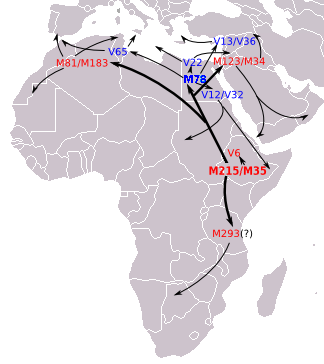Angela
Elite member
- Messages
- 21,823
- Reaction score
- 12,329
- Points
- 113
- Ethnic group
- Italian
See: Meng Lin et al
"[FONT="]Rapid evolution of a skin-lightening allele in southern African KhoeSan[/FONT]
https://www.pnas.org/content/early/2018/12/05/1801948115
It's fast selection on a recent introduction, as I thought, but nice to see it confirmed.
"[FONT="]Skin pigmentation reflects strong local adaptation to latitude after humans migrated around the globe. In the Northern Hemisphere, the gene [/FONT]SLC24A5[FONT="]plays a key role in the genetic basis of light skin pigmentation, where a nonsynonymous mutation in the gene has swept to fixation in contemporary Europeans. Although considered European-specific, we find this mutation at an unexpectedly high frequency in light-skinned KhoeSan from South Africa, far exceeding the European gene flow during colonial migration. Using haplotype analysis and comprehensive demographic modeling including positive selection, we show that this is an example of surprisingly strong adaptation of a recently introduced allele, via back-to-Africa migration, which occurred less than 2,000 y ago.[/FONT][FONT="][h=2]Abstract[/h]Skin pigmentation is under strong directional selection in northern European and Asian populations. The indigenous KhoeSan populations of far southern Africa have lighter skin than other sub-Saharan African populations, potentially reflecting local adaptation to a region of Africa with reduced UV radiation. Here, we demonstrate that a canonical Eurasian skin pigmentation gene, SLC24A5, was introduced to southern Africa via recent migration and experienced strong adaptive evolution in the KhoeSan. To reconstruct the evolution of skin pigmentation, we collected phenotypes from over 400 ≠Khomani San and Nama individuals and high-throughput sequenced candidate pigmentation genes. The derived causal allele in SLC24A5, p.Ala111Thr, significantly lightens basal skin pigmentation in the KhoeSan and explains 8 to 15% of phenotypic variance in these populations. The frequency of this allele (33 to 53%) is far greater than expected from colonial period European gene flow; however, the most common derived haplotype is identical among European, eastern African, and KhoeSan individuals. Using four-population demographic simulations with selection, we show that the allele was introduced into the KhoeSan only 2,000 y ago via a back-to-Africa migration and then experienced a selective sweep (s = 0.04 to 0.05 in ≠Khomani and Nama). The SLC24A5 locus is both a rare example of intense, ongoing adaptation in very recent human history, as well as an adaptive gene flow at a pigmentation locus in humans."
[/FONT]
"[FONT="]Rapid evolution of a skin-lightening allele in southern African KhoeSan[/FONT]
https://www.pnas.org/content/early/2018/12/05/1801948115
It's fast selection on a recent introduction, as I thought, but nice to see it confirmed.
"[FONT="]Skin pigmentation reflects strong local adaptation to latitude after humans migrated around the globe. In the Northern Hemisphere, the gene [/FONT]SLC24A5[FONT="]plays a key role in the genetic basis of light skin pigmentation, where a nonsynonymous mutation in the gene has swept to fixation in contemporary Europeans. Although considered European-specific, we find this mutation at an unexpectedly high frequency in light-skinned KhoeSan from South Africa, far exceeding the European gene flow during colonial migration. Using haplotype analysis and comprehensive demographic modeling including positive selection, we show that this is an example of surprisingly strong adaptation of a recently introduced allele, via back-to-Africa migration, which occurred less than 2,000 y ago.[/FONT][FONT="][h=2]Abstract[/h]Skin pigmentation is under strong directional selection in northern European and Asian populations. The indigenous KhoeSan populations of far southern Africa have lighter skin than other sub-Saharan African populations, potentially reflecting local adaptation to a region of Africa with reduced UV radiation. Here, we demonstrate that a canonical Eurasian skin pigmentation gene, SLC24A5, was introduced to southern Africa via recent migration and experienced strong adaptive evolution in the KhoeSan. To reconstruct the evolution of skin pigmentation, we collected phenotypes from over 400 ≠Khomani San and Nama individuals and high-throughput sequenced candidate pigmentation genes. The derived causal allele in SLC24A5, p.Ala111Thr, significantly lightens basal skin pigmentation in the KhoeSan and explains 8 to 15% of phenotypic variance in these populations. The frequency of this allele (33 to 53%) is far greater than expected from colonial period European gene flow; however, the most common derived haplotype is identical among European, eastern African, and KhoeSan individuals. Using four-population demographic simulations with selection, we show that the allele was introduced into the KhoeSan only 2,000 y ago via a back-to-Africa migration and then experienced a selective sweep (s = 0.04 to 0.05 in ≠Khomani and Nama). The SLC24A5 locus is both a rare example of intense, ongoing adaptation in very recent human history, as well as an adaptive gene flow at a pigmentation locus in humans."
[/FONT]


